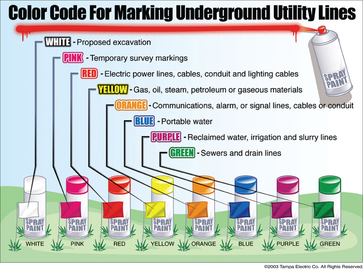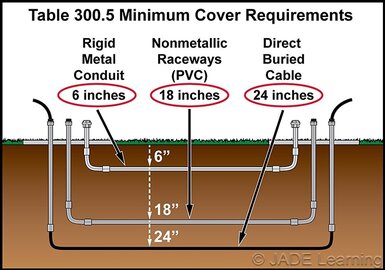If it's my own property, I go deeper, because I don't want to do it twice.
Painful story: I buried two PVC conduits side-by-side for my pool panel feed (3xAWG-6 +G) and lighting circuit (2xAWG-14 + G), all 20 - 24 inches deep, on an 18" requirement. I marked the location using the standard conventional red paint and red flags for high voltage. Next to that was irrigation marked in blue, and irrigation control wiring marked in orange, all standard universal convention colors for each. In another area they had to dig a few posts, I marked the approximate location of an LP gas line conduit in yellow. This isn't something you just make up, these are conventional standard colors for anyone who does site work or digs for a living.
Several feet from that I marked the desired fence location with white paint and pink flags, again standard paint color for "new work" or "dig here", and described what they all meant to the fencing contractor foreman when the crew arrived. He shouted something to his crew in Spanish, and they all jumped into action. I head inside to work on my day job.
I come out an hour later to check on things, and find they're not really following my white line at all. They explained that they had change the curvature of the fence line to make it flow better, and they were right, their way really did look a lot better than mine would have. But somewhere along the line their non-English-speaking guys got the message that the red (high voltage) painted line was where they should put every fence post. Literally every post punched thru the conduit for the lighting circuit, mangling the wiring in a few locations. I ended up pulling half a dozen posts back out myself, digging up half that conduit, pulling out the wiring, and redoing the whole thing. They came back and repaired the fence, after I tore it apart. They set their posts about 24" deep, my conduit was all more than 18" deep (code), but just a few inches shy of where they were digging with their heavy post-hold diggers.
Now I worry about the gas line, PS-2 line inside of PVC conduit. They said they "found it", and I asked if they damaged it, but of course they said no. I didn't have a chance to inspect it before it was re-buried in dirt and concrete, and the location of that post makes pulling it now to inspect, very difficult.






